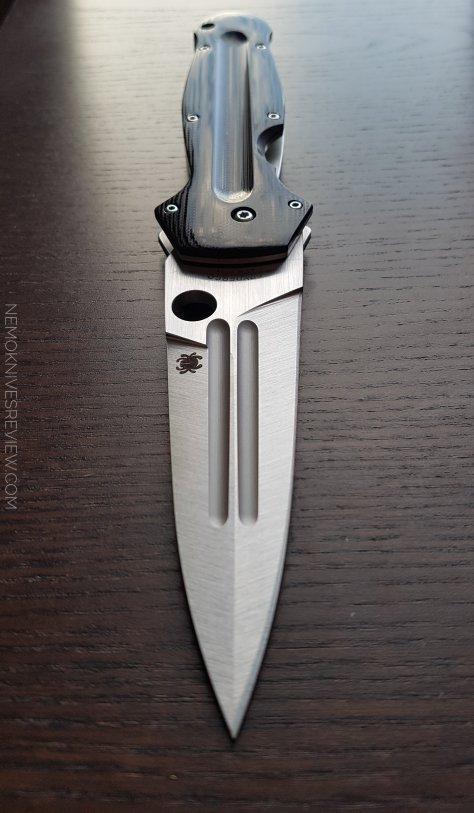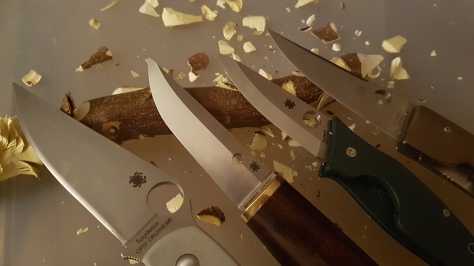

The Ikushi is a very strange Taichung made spyderco and his father, Paul Alexander is a perfectionniste-engineer who got radical new ideas on portable cutlery. Remember the Sliverax ?
My first impression after opening the Knifecenter’s parcel (thank you Howard and Tom for the fast shipment!): wow so slim ! So easy to pocket ! What a great handle to blade ratio !
My friend JD and Pascal introduced me to front flipper with both owning Des Horn and I even was a proud owner of one of them.
The Ikushi is an eye candy. The knife is unique in many ways. It is a tour de force. So let’s quote Spyderco:
“The ultra-slim Spyderco Ikuchi is a radically different approach to pocketknife form and function. Designed by Paul Alexander, a Ph.D. in Mechanical Engineering and a lifelong knife enthusiast, the Ikuchi (pronounced ee-koo-chee and named after a mythical Japanese sea monster) has an elegantly curved handle crafted with full, skeletonized stainless steel liners and stunning carbon fiber/G-10 laminate scales.
In the closed position, the handle’s narrow, open-backed profile completely contains the knife’s blade—except for a small textured section of the tang that serves as a flipper opener. Stroking this section of the blade with an index finger or thumb provides leverage to swiftly pivot it into the open position, where locks securely via Spyderco’s patented Compression Lock™ mechanism. The satin-finished CPM® S30V® stainless steel blade is full-flat ground for exceptional edge geometry and cutting performance and has an acute, scalpel-like point for detailed work.
To ensure discreet carry while keeping the Ikuchi instantly accessible, its handle includes a low-profile, deep-pocket wire clip that is reversible for left or right-side tip-up carry.”
Some user has argued about the point of the blade being able to catch their finger. If clipped to the right pocket, the seam will be against the handle and it is impossible to catch that tip. I can feel that sharp tip with the meat of my finger and I can understand how I could cut myself too. We will see that in future reports.
But first I have asked to Paul Alexander what was is thoughts behind that design.
“I’ve had a version of the Ikuchi in the works for 4-5 years, but only got around to submitting it to Spyderco at the end of 2016. Part of the reason was the non-functional Spydie-hole, which I thought would stop Spyderco from producing it. The release of the Positron and Mantra 2 made me rethink that, and I started to seriously prep it for submission.
The whole design started around the blade shape. My dad has always preferred a narrow blade because it’s easier to turn the blade in the middle of a cut if you are paring, whittling, etc. Most of my designs have had a fairly wide blade, and I wanted to do something that would fit his preferences a bit more. He’s also been partial to the narrow clip blade found on the American traditional muskrat knives, and the Ikuchi blade shape is my version of that. Sticking with the traditional inspiration, I used the toothpick handle pattern as the inspiration, which also kept the entire knife nice and slim. In the end, I suppose the whole thing came out looking like a modernized Laguiole… which is likely the design which originally inspired the American toothpick pattern.
The wheel flipper was a slower evolutionary process that was a collaborative effort with the Spyderco team. Eric had sort of mentioned that he was curious about adapting the compression lock to a flipper opening mechanism when I first started working with Spyderco, and I tried coming up with a handful of options, with this being one of them. I originally had more of a tab-like interface on the flipper surface on the Ikuchi design, and that morphed into the final wheel configuration through iterations and refinement with input and prototypes from Spyderco.
The early phases of that development process got me so excited for the Ikuchi, I adapted the locking and flipper geometry to three other traditional knife patterns and blade shapes I liked, and created a series of knives. I called the series by the working title of the ‘Four Horsemen’, and tried to tap into that theme for the look and style of all four pieces in the series. The Ikuchi was initially code named ‘Famine’, which fit the inspirational traditional pattern’s name and the overall aesthetic of the design. The other horsemen designs are ‘Pestilence’, ‘War’, and ‘Death’, but that seemed too dark of a theme to use for the marketing of the designs, so I officially named them all after different mythological beasts… and that’s how the Ikuchi became the Ikuchi.”
Mine is not as easy to open/fire as I thought.
The detent is quite strong and it can be a hit and miss. I have hurt my index finger and failed attempt to fire open the knife. Not fun.
I wonder if it will get better but not being able to trust the fact to simply open it…
I have asked Paul.
Some beautiful Tour de Force but not flawless. I would be need to be certain the tip of the blade once closed won’t catch anything in my pocket and to be certain I can open the knife easily and not only half of the time. Unless I need to strenghten the tip of my index ?As you can notice this is the first design which can be easily locked to prevent children to play with it.
Also the flipper once open acts as a guard for your finger but not on a design like the Ikushi. I have never trusted a locking system even on balisongs so it is a knife which is intended to be used as a gentle tool: beautiful to admire as an engineer’s dream.
How will it perform in day to day basis ? We will see.









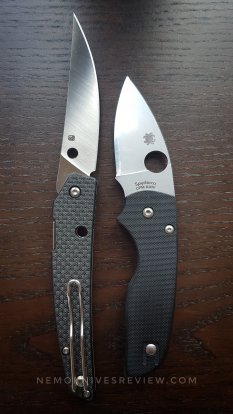



 My
My  You can see I have mounted my Ed Schempp Bowie clip for now. Now that I feel confident with S30V heat treated by Spyderco, since I have play with the Nilakka (Taichung) and the Wolfspyder (Golden), both radicaly scandi ground knives, I have decided to give the Nilakka a very very thin convex edge.
You can see I have mounted my Ed Schempp Bowie clip for now. Now that I feel confident with S30V heat treated by Spyderco, since I have play with the Nilakka (Taichung) and the Wolfspyder (Golden), both radicaly scandi ground knives, I have decided to give the Nilakka a very very thin convex edge. 





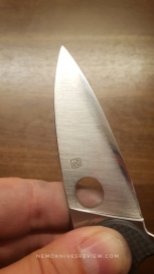


 On plastic and wood, I have twisted the blade inside and no harm has been noticed to the edge or the mechanism. I have used it hard at full grip and got full confidence in it in hammer or reverse grip. Like on the other compression locks knives it’s so easy to close it and put it back in the pocket, preventing any way to harm yourself or the others. It is especially great when working around animals like horses for example, when you want your edge to be out of play as soon as possible.
On plastic and wood, I have twisted the blade inside and no harm has been noticed to the edge or the mechanism. I have used it hard at full grip and got full confidence in it in hammer or reverse grip. Like on the other compression locks knives it’s so easy to close it and put it back in the pocket, preventing any way to harm yourself or the others. It is especially great when working around animals like horses for example, when you want your edge to be out of play as soon as possible. 








 Oh and I really enjoy the fact their zero jimping. Most of the time I’m obliged to file them a bit on the corner to have them to my taste. Here no need for jimping and as a tool the Sliverax is perfectly anchord to my hand. The CF/G10 material is working perfectly without chewing my pants. After EDCing
Oh and I really enjoy the fact their zero jimping. Most of the time I’m obliged to file them a bit on the corner to have them to my taste. Here no need for jimping and as a tool the Sliverax is perfectly anchord to my hand. The CF/G10 material is working perfectly without chewing my pants. After EDCing 


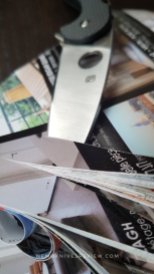





 There is a lot of matter to remove and by hand, it takes some time.
There is a lot of matter to remove and by hand, it takes some time.



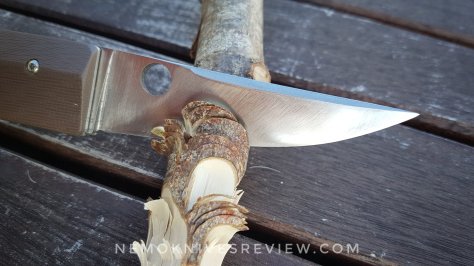





















 It has all started when I wanted to review the Spyderco Gayle Bradley Junction. It’s a great design for an EDC fixed blade which can be used for everything. Easy to carry in its pancake constructed bolteron sheath. But the edge was just too thick for my own use.
It has all started when I wanted to review the Spyderco Gayle Bradley Junction. It’s a great design for an EDC fixed blade which can be used for everything. Easy to carry in its pancake constructed bolteron sheath. But the edge was just too thick for my own use.  To my knowledge, SPF27 is some kind of CPM D2 steel. A lot of carbon 1.5% and not a lot of chromium around 12%. Not the easiest on the stone as a semi stainless. It was not very soft under the diamonds compared to another blade in N690 HRC59 I got with me. And it was not really easy to remove the shoulder to create a gentle convex edge. Patience… In sharpening is important. And I often lack of it but I was able to improve it.
To my knowledge, SPF27 is some kind of CPM D2 steel. A lot of carbon 1.5% and not a lot of chromium around 12%. Not the easiest on the stone as a semi stainless. It was not very soft under the diamonds compared to another blade in N690 HRC59 I got with me. And it was not really easy to remove the shoulder to create a gentle convex edge. Patience… In sharpening is important. And I often lack of it but I was able to improve it.  Next some black stone mostly to remove the scratches.
Next some black stone mostly to remove the scratches.  And then the white ceramic to get a better finish and a razor steel.
And then the white ceramic to get a better finish and a razor steel.  You can notice the chamfered signature hole on the Junction. A première. The cuts were deeper. It was better! Much more enjoyable.
You can notice the chamfered signature hole on the Junction. A première. The cuts were deeper. It was better! Much more enjoyable.  But the spine was too sharp for my thumb and diamonds came handy to rounded the angles. It would never be a Sebenza spine….
But the spine was too sharp for my thumb and diamonds came handy to rounded the angles. It would never be a Sebenza spine….  Again the control during whittling was much much better. One should never be scared to round the edges for suiting your own needs.
Again the control during whittling was much much better. One should never be scared to round the edges for suiting your own needs.  The handle is very flat on that knife. It’s an attention for people who wish to stash their knife in a pocket or a backpack without leaving a print.
The handle is very flat on that knife. It’s an attention for people who wish to stash their knife in a pocket or a backpack without leaving a print.  But a flat knife is not the most comfortable in the palm of your hand… Especially when cutting hard things for a long time.
But a flat knife is not the most comfortable in the palm of your hand… Especially when cutting hard things for a long time.  I decided to make a quick comparison with the Spyderco Sprig which is a pleasure to use.
I decided to make a quick comparison with the Spyderco Sprig which is a pleasure to use.  You can notice how the Phil Wilson’s Sprig got a thicker handle. And it change everything when cutting hard things. Also Phil Wilson’s is all about performances. Its geometry is stellar.
You can notice how the Phil Wilson’s Sprig got a thicker handle. And it change everything when cutting hard things. Also Phil Wilson’s is all about performances. Its geometry is stellar.  It immediately cuts deep in wood without any real improvement needed….
It immediately cuts deep in wood without any real improvement needed….  But diamonds were there to be usef. 🙂
But diamonds were there to be usef. 🙂  I was able to get thin regular cuts into the wood. So I have decided to try the diamonds on the Gayle Bradley Bowie I have brought with me. This one got a thicker geometry and is made if the same pulverized alloy as the Junction
I was able to get thin regular cuts into the wood. So I have decided to try the diamonds on the Gayle Bradley Bowie I have brought with me. This one got a thicker geometry and is made if the same pulverized alloy as the Junction  You can always improve an edge.
You can always improve an edge.  Used as a light chopper it worked just fine.
Used as a light chopper it worked just fine.  Gayle Bradley has provided a great compact Bowie which can be used as a light camp knife.
Gayle Bradley has provided a great compact Bowie which can be used as a light camp knife.  You can see: it’s not a lot bigger compared to my Ed Chempp Bowie.
You can see: it’s not a lot bigger compared to my Ed Chempp Bowie.  And the edge once thinned is honorable.
And the edge once thinned is honorable.  Of course it is not as thin as my Pekka Tuominen Urban II for example. And not as aggressive as the Sprig…
Of course it is not as thin as my Pekka Tuominen Urban II for example. And not as aggressive as the Sprig… 
 I got…. too much knives on my table…
I got…. too much knives on my table…  An Francesca knows how to prepare the pasta with pomodori.
An Francesca knows how to prepare the pasta with pomodori.  Crostini a la Toscane. Poultry liver, oignons, red wine, bread and a Bowie.
Crostini a la Toscane. Poultry liver, oignons, red wine, bread and a Bowie. 
 Back in the outside I was thinking of a simple way to see the “impact” of good geometry on whittling. On the right, a single cut if the thin Delica and, on the left, a single cut of the thicker
Back in the outside I was thinking of a simple way to see the “impact” of good geometry on whittling. On the right, a single cut if the thin Delica and, on the left, a single cut of the thicker  Also the Delica was able to cut from the ricasso to the point without any hard pressure. In the end, I had noticed that the Junction was less good than the Sprig and the Delica was still the best whittler in the batch. No matter the steel, for wood cutting, geometry is queen. So I have taken my Bowie back to the diamonds and put a keener edge. Tomorrow it will be hunting day.
Also the Delica was able to cut from the ricasso to the point without any hard pressure. In the end, I had noticed that the Junction was less good than the Sprig and the Delica was still the best whittler in the batch. No matter the steel, for wood cutting, geometry is queen. So I have taken my Bowie back to the diamonds and put a keener edge. Tomorrow it will be hunting day. 

